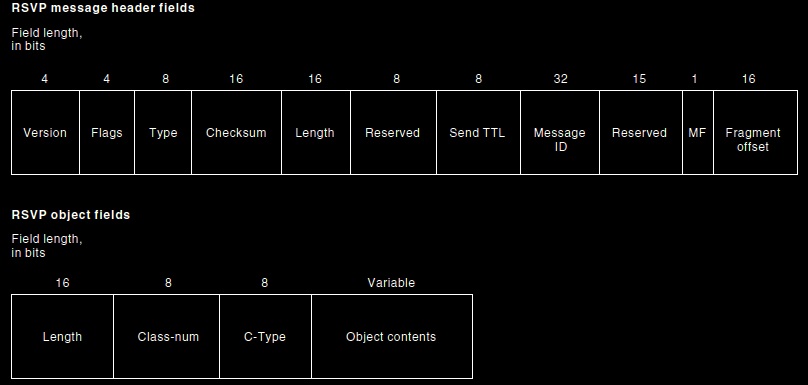- Subscribe to RSS Feed
- Mark as New
- Mark as Read
- Bookmark
- Subscribe
- Printer Friendly Page
- Report Inappropriate Content
- Subscribe to RSS Feed
- Mark as New
- Mark as Read
- Bookmark
- Subscribe
- Printer Friendly Page
- Report Inappropriate Content
06-09-2009 02:52 AM - edited 03-01-2019 03:34 PM
Introduction:
Resource reservation Protocol (RSVP) is signaling protocol that enables and end stations or application to obtain special Qos for their flows, basically, RSPV reserve bandwidth for the application. RSVP does not transport application data but is rather an internet control protocol, like Internet Control Message Protocol (ICMP), Internet Group Management Protocol (IGMP) or routing protocols. RSVP is also known as Resource reservation setup Protocol (RSVP).
RSVP is used by a host to request specific Qos from the network for particular application data stream or flow. RSVP request generally result in resources being reserved in each node along the data path.
RESV and PATH messages:
An RSVP Packet Format Consists of Message Headers and Object Fields

There are two general message types in RSVP, PATH, and RESV. The initial request begins with a PATH message. The PATH message describes the specific flow that will use this reservation. So it includes the source and destination IP addresses, as well as the IP Protocol, such as TCP or UDP, and any port numbers. The PATH message also includes the requested average bit rate and burst size.
The PATH message is received by an upstream router, or perhaps the ultimate destination. If it is received by an intermediate router, this router must analyze the request and decide whether it can honor it. Ultimately, if the request is accepted, the router will create a new PATH message, requesting the same resource reservation from the next upstream router, but specifying itself as the source.
PATH messages always flow from the requester toward the destination.
RESV messages flow the opposite direction. The RESV CONFIRM messages describe the actual detailed bit rate and delay characteristics required to fulfill the PATH request. If an upstream router doesn't have the necessary resource to fulfill the request, it responds with an RESV ERROR message.
In Cisco router configuration, you can configure static PATH requests by using the "ip rsvp sender and sender-host" commands. And you can make static reservations, which will be described to upstream routers in RESV messages, using the "ip rsvp reserveration and reservation-host' commands.
RSVP Operation:
An RSVP host that needs to send a data flow with specific QoS will transmit an RSVP path message every 30 seconds that will travel along the unicast or multicast routes pre-established by the working routing protocol. If the path message arrives at a router that does not understand RSVP, that router forwards the message without interpreting the contents of the message and will not reserve resources for the flow.
Those who want to listen to them send a corresponding resv (short for "Reserve") message which then traces the path backwards to the sender. The resv message contains the flow specs. When a router receives the RSVP resv message it will:
Make a reservation based on the request parameters. For this the admission control and policy control process the request parameters and can either instruct the packet classifier to correctly handle the selected subset of data packets or negotiate with the upper layer how the packet handling should be performed. If they cannot support the reservation being requested, they send a reject message to let the listener know about it.
Forward the request upstream (in the direction of the sender). At each node the resv message flowspec can be modified by a forwarding node (e.g. in the case of a multicast flow reservation the reservations requests can be merged).
The routers then store the nature of the flow, and also police it. This is all done in soft state, so if nothing is heard for a certain length of time, then the reader will time out and the reservation will be cancelled. This solves the problem if either the sender or the receiver crash or are shut down incorrectly without first cancelling the reservation. The individual routers may, at their option, police the traffic to check that it conforms to the flow specs.
Basic RSVP configuration:
Basic RSVP configuration is simple.You need to define how much bandwidth can be reserved on the interface:
Router#configure terminal
Enter configuration commands, one per line. End with CNTL/Z.
Router(config)#interface FastEthernet0/0
Router(config-if)#ip rsvp bandwidth 128 56
Router(config-if)#end
Router#
The first numerical argument, 128, specifies that applications can reserve a maximum aggregate bandwidth of 128 Kbps. The last argument, 56, means that the largest amount that a single application can request is 56 Kbps.
Some network administrators have to worry about unauthorized use of bandwidth reservation. You can control this by specifying an access-list of allowed neighbor devices:
Router#configure terminal
Enter configuration commands, one per line. End with CNTL/Z.
Router(config)#interface FastEthernet0/0
Router(config-if)#ip rsvp bandwidth 128 56
Router(config-if)#ip rsvp neighbor <Access_list_Number>
Router(config-if)#end
Router#
Before you can configure RSVP on an interface, you must first configure the interface for WFQ, CBWFQ, or WRED.
Verification:
There are several useful show commands to look at the RSVP configuration of your router as follow;
Router#show ip rsvp interface
Router#show ip rsvp installed
Router#show ip rsvp reservation
Router#show ip rsvp neighbor
RFCs
Also See
Find answers to your questions by entering keywords or phrases in the Search bar above. New here? Use these resources to familiarize yourself with the community: